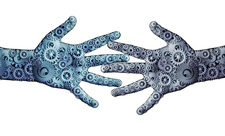An Amiga emulator for the Raspberry Pi 400
Mimic

© Lead Image © Lightwise, 123rf.com
Convert a Raspberry Pi 400 into a retro computer that behaves like the popular Amiga 500.
The Commodore Amiga was more than a gaming platform; its graphical interface, Workbench, was way ahead of its time. The Amiga models [1] rank among the particularly popular home computers of the 1980s and 1990s. The A500, A1200, and several other Amigas had the motherboard and a floppy drive integrated into the keyboard case. More professional variants like the A3000 were built more like a PC and housed the mainboard, expansion cards, and drives in a desktop or tower case.
According to Wikipedia [1], the Amiga 500 is the best-selling model, which is what prompted Retro Games Ltd. to launch a replica to be released in March 2022, dubbed the A500 Mini (Figure 1) [2]. The manufacturer is already known for reissues of other Commodore computers, such as the C64 (in miniature format and full size with a working keyboard) and VC20 (full size only).
For a good Amiga emulation, you don't have to wait for the A500 Mini. Emulators are available for practically all platforms (even for the old MS-DOS) that bring that Amiga feel to other hardware with varying levels of setup overhead. In the Raspberry Pi world, the Pi 400 is a very good choice for use as an Amiga emulator because, like the original keyboard Amigas, it combines a keyboard, mainboard, and storage device in a single housing.
[...]
Buy this article as PDF
(incl. VAT)
Buy Linux Magazine
Subscribe to our Linux Newsletters
Find Linux and Open Source Jobs
Subscribe to our ADMIN Newsletters
Support Our Work
Linux Magazine content is made possible with support from readers like you. Please consider contributing when you’ve found an article to be beneficial.

News
-
Fedora 43 Has Finally Landed
The Fedora Linux developers have announced their latest release, Fedora 43.
-
KDE Unleashes Plasma 6.5
The Plasma 6.5 desktop environment is now available with new features, improvements, and the usual bug fixes.
-
Xubuntu Site Possibly Hacked
It appears that the Xubuntu site was hacked and briefly served up a malicious ZIP file from its download page.
-
LMDE 7 Now Available
Linux Mint Debian Edition, version 7, has been officially released and is based on upstream Debian.
-
Linux Kernel 6.16 Reaches EOL
Linux kernel 6.16 has reached its end of life, which means you'll need to upgrade to the next stable release, Linux kernel 6.17.
-
Amazon Ditches Android for a Linux-Based OS
Amazon has migrated from Android to the Linux-based Vega OS for its Fire TV.
-
Cairo Dock 3.6 Now Available for More Compositors
If you're a fan of third-party desktop docks, then the latest release of Cairo Dock with Wayland support is for you.
-
System76 Unleashes Pop!_OS 24.04 Beta
System76's first beta of Pop!_OS 24.04 is an impressive feat.
-
Linux Kernel 6.17 is Available
Linus Torvalds has announced that the latest kernel has been released with plenty of core improvements and even more hardware support.
-
Kali Linux 2025.3 Released with New Hacking Tools
If you're a Kali Linux fan, you'll be glad to know that the third release of this famous pen-testing distribution is now available with updates for key components.

